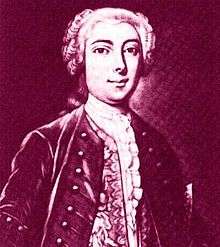Gioacchino Conti
Gioacchino Conti (28 February 1714 – 25 October 1761), best known as Gizziello or Egizziello, was an Italian soprano castrato opera singer.

Biography
Conti was born in Arpino in 1714, possibly the son of the composer Nicola Conti.[1] After studying in Naples with Domenico Gizzi, after whom he would later be nicknamed, he made his debut in Rome at an early age, around 1730. According to some modern encyclopedic sources, it took place in Leonardo Vinci's Artaserse, which premiered on 4 February at the Teatro delle Dame.[2] However, his name does not appear in the cast of the original libretto,[3] and his theatrical debut ought probably to be dated instead in 1731, in revivals of Didone abbandonata and of the same Artaserse, both by Vinci.[4] A colourful anecdote relates how another overweening castrato star, Caffarelli, rode post-haste to Rome from Naples just to attend incognito his debut; and full of enthusiasm eventually yelled at him: "Bravo, bravissimo Gizziello, it’s Caffariello who's telling you!"[5] Whatever the case, at the beginning of 1732 he was urgently called upon to replace the castrato Nicolò Grimaldi (Nicolini), who suddenly died on 1 January during the rehearsals of Pergolesi's first opera La Salustia at the Teatro San Bartolomeo in Naples.[6] Having become a member of the theatre's company, later that year he performed in new operas by Johann Adolf Hasse, Leonardo Leo and Francesco Mancini,[7] and in revivals of Vinci's Catone in Utica and Artaserse.[8]
His subsequent career led him throughout Italy, as well as abroad. In 1736–37 he was in London, where he had been engaged by George Frideric Handel, with whom he would build a profitable collaboration. Conti performed in many of his works, such as Atalanta, Giustino, Berenice and Arminio, as well as in a revival of Ariodante.
He sang at many premieres for the best and most famous musicians of his time, including Niccolò Jommelli (Manlio, 1746), Baldassare Galuppi (Artaserse, 1751) and Johann Adolf Hasse (Demetrio, 1747).
After 1759, Conti left the stage and settled in Rome, where he spent the last two years of his life.
Being a very sharp soprano for his time (Handel got him repeatedly to reach up to C6), Conti was not quite well disposed towards abuse of coloratura and he chose rather to turn to better account his fluent and smooth style of rendering and expression: he has thus remained famous as a sentimental and gentle singer, but he also always kept a condition of absolute excellence at vocal virtuosity, even though not so acrobatic as, for instance, that of his contemporary (and friend) Farinelli.[9]
References
- Dean.
- Caruselli; Dean; Lisena.
- Artaserse. Drama per Musica di Pietro Metastasio Romano tra gli Arcadi Artino Corasio. Da rappresentarsi nel Teatro detto delle Dame nel Carnevale dell'anno 1730, Rome, Zempel e de Mey, s.d. (1730), p. 8 (accessible for free online at IMSLP Archived 2015-11-17 at the Wayback Machine). See also Kurt Sven Markstrom, The Operas of Leonardo Vinci, Napoletano, Hillsdale NY, Pendragon Press, 2007, p. 304, ISBN 978-1-57647-094-7.
- Fétis, p. 351; Villarosa, p. 54.
- Francesco Florimo, Cenno storico sulla Scuola musicale di Napoli, Naples, Rocco, 1869, II, p. 2042 (accessible for free online at Internet Archive). It is likely to be a legend.
- Maria Grazia Sità, Salustia, in Piero Gelli and Filippo Poletti (eds), Dizionario dell'opera 2008, Milan, Baldini Castoldi Dalai, 2007, pp. 1176-1177, ISBN 978-88-6073-184-5 (the article is reproduced online at OperaManager.com Archived 2015-11-17 at the Wayback Machine).
- Cf. catalogue of the performances by Conti in the website GFH (Handel for ever).
- Conti's appearances in Catone in Utica and Artaserse are stated by Benedetto Croce, in I teatri di Napoli. Secolo XV-XVIII, Napoli, Pierro, 1891, p. 298 (accessible for free online at Internet Archive).
- Caruselli, I, p. 295. Conti always remained in good terms with Farinelli, who repeatedly invited him to Spain, terming him "Antiguo amigo" (longtime friend) (Sandro Cappelletto, La voce perduta: vita di Farinelli, evirato cantore, Turin, EDT, 1995, p. 108. ISBN 88-7063-223-7)
Sources
- (in Italian) Rodolfo Celletti, Storia del belcanto, Fiesole, Discanto Edizioni, 1983, pp. 105–106, 125.
- (in Italian) Salvatore Caruselli (ed.), Grande enciclopedia della musica lirica, Rome, Longanesi &C. Periodici S.p.A. (article: Conti, Gioacchino, detto Gizziello, I, p. 295)
- Winton Dean, Conti, Gioacchino ['Egizziello', 'Gizziello'], in Stanley Sadie (ed.), The New Grove Dictionary of Opera, New York, Grove (Oxford University Press), 1997, I, pp. 927–928, ISBN 978-0-19-522186-2
- (in French) François-Joseph Fétis, Biographie universelle des musiciens et bibliographie générale de la musique (second edition), Paris, Didot, 1866, II, pp. 350-352 (article: Conti (Joachin); accessible for free online at Gallica - BNF)
- (in Italian) Corrado Lisena, Conti, Gioacchino, in Dizionario Biografico degli Italiani, Volume 28, 1983, accessible online at Treccani.it.
- (in Italian) Carlantonio di Villarosa, Memorie dei compositori di musica del Regno di Napoli raccolte dal Marchese di Villarosa, Naples, Stamperia Reale, 1840, pp. 53-54 (article: Conti Gioacchino; accessible for free online at Books Google)